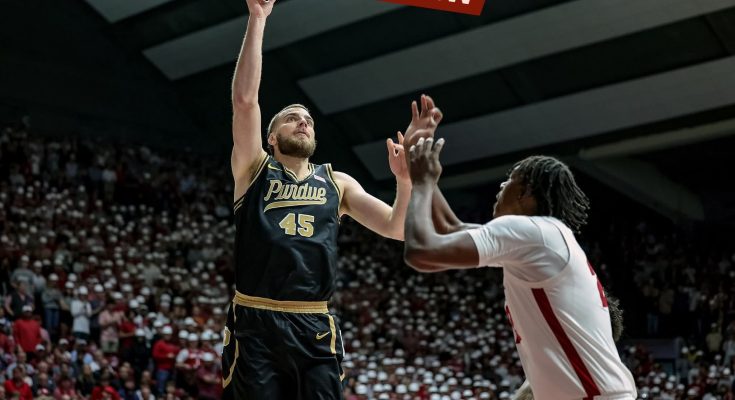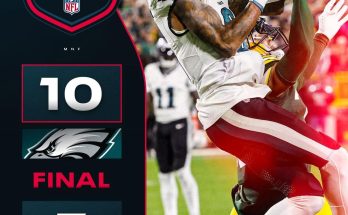In a loss to Purdue, Alabama’s rebounding margin of minus-24 was the second-worst of the Nate Oats era, and it represented more than a single-game statistical anomaly. It was a vivid, revealing snapshot of both where the program currently stands and the challenges that continue to surface when Alabama faces elite frontcourt size and physicality. A rebounding margin that wide is usually not the product of one factor, nor is it something that can be dismissed as simply an off night. Instead, it exposes systemic issues—schematic, personnel-related, and psychological—that have occasionally surfaced throughout the Oats era, even during years when Alabama was a top-10 program and a tournament threat.
Purdue is, admittedly, an outlier in college basketball. Few teams can throw 7-foot-4 Zach Edey at you with a rotating cast of frontcourt players who would be starting centers elsewhere. Purdue’s philosophy is single-minded and unapologetic: win the possession battle, dominate the glass, and impose a physicality that forces opponents out of rhythm. Yet even with that in mind, a minus-24 margin is not simply a matter of running into the sport’s most physically imposing team. It suggests a deeper mismatch between how Alabama wants to play and how it must play to beat the best teams in the country.
Under Nate Oats, Alabama’s style has been one of the most distinctive and analytically optimized in college basketball: pace, spacing, threes, rim attempts, and defensive disruption. The goal is to win with math and tempo, not by engaging in the wrestling match that so many Big Ten-heavy rosters thrive in. When Alabama is humming—hitting threes, forcing turnovers, and running—its style overwhelms opponents. The Tide has shown that repeatedly, especially in the 2020–21 and 2022–23 seasons when they made deep NCAA tournament runs and earned high seeds. But when that system encounters a team capable of eliminating transition opportunities and punishing Alabama on the boards, the analytics bend sharply in the other direction. Rebounding has always been the most glaring vulnerability of the scheme, partly because of philosophy and partly because of personnel choices. Oats has tended to prioritize versatile, switchable forwards rather than traditional big men. This enhances offensive spacing and defensive flexibility, but it also leaves Alabama with fewer natural rebounders, especially against teams that dedicate nearly every possession to crashing the glass with numbers and size. When faced with frontcourts that emphasize brute strength over mobility, Alabama’s speed advantage can be neutralized before it matters, and the game devolves into one played at the opponent’s preferred pace.
The Purdue game embodied exactly that scenario. Alabama’s initial defensive stops rarely resulted in immediate possession changes, because Purdue simply gathered the ball again and again. Missed box-outs, mistimed jumps, and strategic disadvantages compounded. Even when Alabama defenders were in position, Purdue’s length allowed them to reach over or around in ways that SEC opponents often cannot. Second-chance points flowed. The Tide’s usual rhythm evaporated. One offensive possession for Alabama often had to fight through a set defense, while Purdue frequently got two or three shots before the possession ended. A team as efficient as Purdue does not need many chances, and a team like Alabama cannot afford to surrender nearly two dozen extra opportunities and expect to keep the mathematical balance of its system intact.
But the problem goes beyond this single matchup. The minus-24 margin forces a larger conversation about what Alabama needs to do when facing elite rebounding teams, particularly in March. Some matchups can simply be chalked up to “bad draw,” but when the same issue arises periodically, including in tournament settings, it becomes a structural concern. Last season, Alabama’s defense regressed sharply, largely due to interior issues. While the offense was elite, efficiency cannot just be built on outscoring the opponent; it must include ways to win games when shots are not falling. Rebounding is the most stable statistic in basketball—it does not rely on luck or timing—and strong rebounding teams often advance in the NCAA tournament because possessions become more precious under pressure. Alabama has excelled at creating high-volume shot attempts but has too often allowed opponents to create the same through offensive rebounds. This nullifies one of the Tide’s core advantages.
The solution is not as simple as “recruit bigger players.” Oats has demonstrated an ability to adapt his scheme around talent, and Alabama has brought in skilled frontcourt players. But none have been true dominant rebounders in the way that Purdue regularly deploys. The system itself also de-emphasizes sending multiple players to the defensive glass, favoring transition opportunities. When the opponent crashes relentlessly, Alabama often chooses between contesting the rebound with extra bodies or preserving its fast-break potential. Against most teams, the balance favors transition; against Purdue, that tradeoff becomes untenable. At some point, Alabama must develop the ability to toggle between styles depending on opponent—maintaining its pace-first identity while still being able to grind out defensive rebounds when the opponent forces that style onto the game.
It is also important to consider the psychological component. Rebounding is often framed as an effort statistic, though that’s only partly true. Technique and positioning matter significantly. But effort becomes magnified when facing a team whose defining trait is physical dominance. Purdue plays a style that can make teams feel small. When a team senses that rebounds will not come easily, there can be a subtle but real drop in aggression, a hesitation at the point of contact, a feeling that the opponent is simply stronger. Alabama has to combat this mentality. Championship teams win not only on skill and scheme but in the willingness to meet physical challenges head-on even when they lie outside their comfort zone. The Tide have, at times, demonstrated this toughness—particularly in certain SEC matchups over the years—but inconsistency in that area remains a narrative that games like this reinforce.
From a broader perspective, this minus-24 rebounding night should be viewed as an inflection point rather than merely a disappointing statistic. Alabama remains among the most dangerous offensive teams in the country and capable of beating anyone when the spacing, tempo, and shot-making come together. The question is whether they can raise the floor of their performance for matchups where the style of play must become less about pace and more about control. Purdue, despite its recent postseason struggles, thrives on transforming games into their preferred style. In the NCAA tournament, Alabama will not face a team like Purdue every round, but they will almost certainly face a team with a strong interior presence at some point, whether from the Big 12, Big Ten, or an SEC opponent familiar with their pace. If the Tide cannot hold their own on the boards in those matchup-dependent settings, their offensive advantages will not be enough to carry them through a bad shooting night.
This does not mean Alabama needs to overhaul its system, abandon threes, or recruit a rotation of 7-footers. It means the program must find ways within its existing identity to bridge the gap in matchups like this. Better rotational discipline, stronger box-out fundamentals, more physical perimeter rebounding, and lineup flexibility can all contribute to narrowing the disparity. There is an art to rebounding as a team rather than relying on a dominant individual rebounder, and Alabama has shown flashes of this in the past. When guards commit to rebounding, when forwards initiate contact early rather than reacting late, when the team collapses as a unit, the results can be respectable even against stronger opponents. But consistency is what separates good teams from Final Four-caliber teams. Until Alabama proves it can repeat those habits under pressure, questions will linger.
The encouraging aspect is that Nate Oats has shown the ability to self-correct. Each of his teams has, by the end of the season, been better than it was early in nonconference play. Alabama deliberately schedules difficult opponents in November and December so that weaknesses are revealed while they can still be addressed. Losses in December do not define a season; they sharpen it. The minus-24 rebounding margin tells Alabama exactly where it must improve, and the staff is likely already dissecting every missed box-out, every rotation, every instance of guards leaking out too early. Growth is neither linear nor immediate, but Alabama has the tools to adjust if the commitment is there.
Ultimately, the loss to Purdue serves as both a warning and an opportunity. It warns that no matter how potent Alabama’s offense is, certain weaknesses cannot be masked against elite competition. It shows what happens when an opponent turns the game into a battle of strength instead of speed. But it also offers an opportunity—because losses that expose weaknesses do more good in the long term than comfortable wins that hide them. If Alabama uses this as a catalyst to elevate its physicality, rebounding focus, and tactical flexibility, it will be significantly more prepared when the games matter most in March.
Minus-24 may represent the second-worst rebounding performance of the Nate Oats era, but its value is not simply in the number. Its significance lies in what the program chooses to do with it. If Alabama treats it as a turning point, it can help build a tougher, more balanced team—one capable not only of overwhelming opponents with pace and threes, but also of surviving and winning the bruising matchups that define championship runs.



